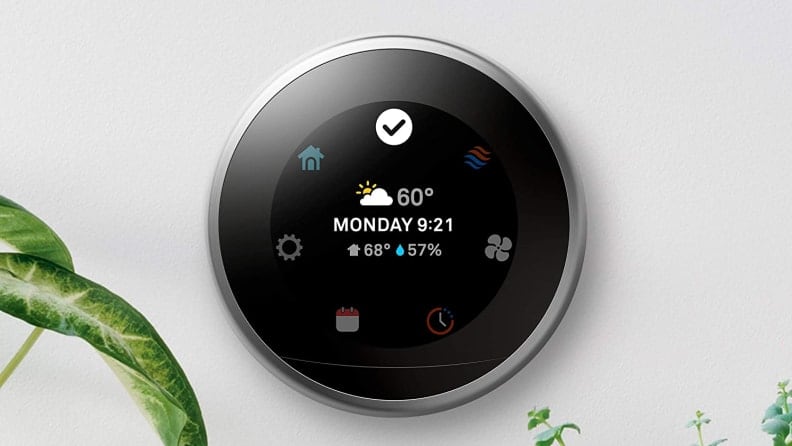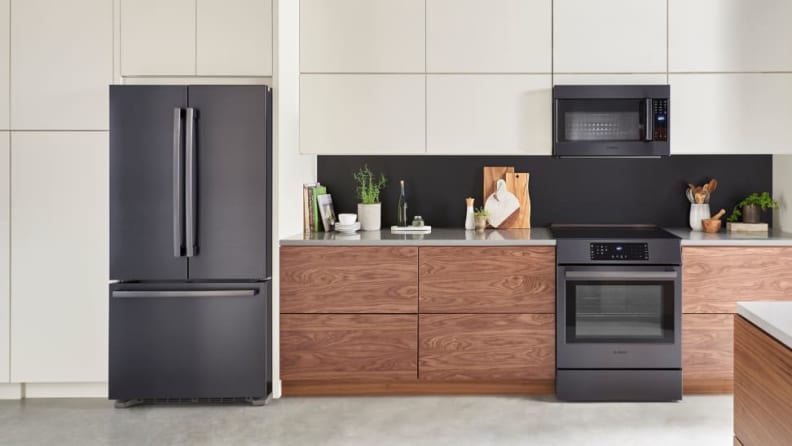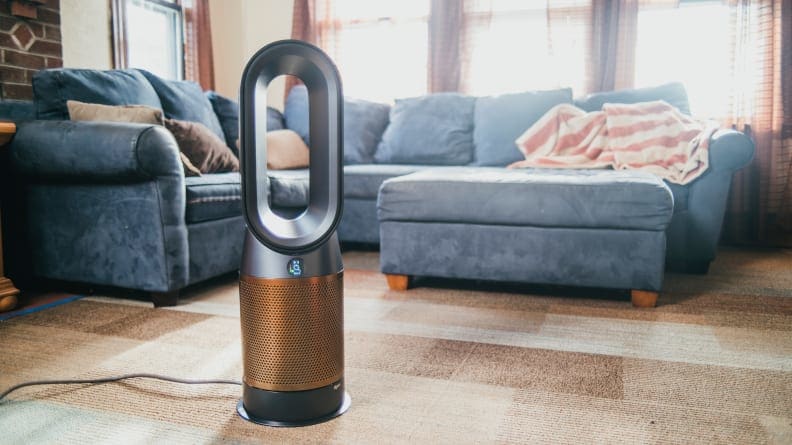12 New Year's resolutions to make for your home
It’s time to embrace organization and green grass
Products are chosen independently by our editors. Purchases made through our links may earn us a commission.
As we move into 2022, after another tough year, there's no doubt that change is at the forefront of thought. You likely have personal New Year's resolutions in your pocket, but what about for the place that you've been spending the majority of your time?
Every home can use a refresh, and there's no better time to do so than now, whether you just need to change up the look of your living room, replace a broken appliance, or finally clean your garage.
In case you're stuck for ideas, we came up with 12 projects for you to consider.
1. Rearrange furniture and wall décor for a fresh look
If there’s any year to start with a clean slate, it’s this one. If you’re sick of the look of the living room, dining room, or rec room that you’ve recently spent entirely too much time in, but you can’t afford new furniture or a complete renovation, try a mini makeover.
Sometimes all it takes is repositioning furniture and freshening up wall décor for a whole new vibe. Embrace the art deco style that's gained popularity in 2021. Buy a few mirrors or frames to create a gallery wall. You can also try color-blocking your walls or putting a Very Peri spin on your apartment—a gallon of paint typically doesn’t cost more than about $40.
Some social platforms like Houzz and Pinterest offer ideas and inspiration. A few 2022 Pinterest trend predictions include bringing luxury elements into your home, especially if they don't also have luxury price tags, creating a home office where you can manage your side hustle, turning a spare room into an "emotional escape room," and building in pet-friendly elements like nooks and dog-specific furniture.
2. Get smart gear to save on energy costs

Using a smart thermostat like Nest means that you’ll be connecting your heating system to the internet, allowing you to set up a schedule that makes sense for your needs and budget.
Work smarter, not harder. Energy Star suggests using smart thermostats, smart lighting, and smart appliances to save costs.
While every home’s heating and cooling system has its quirks—vintage steam radiators, anyone?—depending on the age of the home, most are compatible with smart thermostats made by Ecobee, Honeywell, Emerson, and Nest, the best smart thermostat we've tested.
Replacing your manual dial with one of these 21st-century devices means that you can connect your heating system to the internet, allowing you to control it via a smartphone app and set up a schedule that makes sense for your needs. You save money because you won’t be as apt to heat an empty house or rooms that you just don’t use.
Similarly, you can make the smart switch in your home’s lighting systems. First eliminate all incandescent light bulbs, which use a lot more energy than LED lights. LED smart bulbs by our top-ranking Philips, as well as Eufy, GE, and Sengled, are installed like you would any other lightbulb and then connect to work with a hub like Google Home or via Bluetooth. This allows you to control color (think cool blue or warm white) and brightness, as well as when and if they’re operational.
Lastly, if you've got the budget, replace old appliances, including the fridge, dishwasher, over, washer and dry, with new, Energy Star or energy efficient ones. Doing so will not only save you energy, it'll save you money.
3. Clean out your basement, garage, or attic
Start 2022 off fresh with a cathartic decluttering of your hot mess. Getting organized has been gaining steam since 2020, and it's still going strong. If you haven’t jumped aboard this train yet, now’s the time to do so.
Areas of the home that you don’t typically see day to day—like the basement, garage, and attic—tend to accumulate the stuff we don’t know what to do with or put aside to deal with later.
Take a look to organizing gurus like Marie Kondo, Martha Stewart, and The Home Edit for inspiration. All have lines of shelving, storage bins, and more at popular retailers. Buy some, and get moving.
If the weather is fair where you are, throw a yard sale to cover your organizing costs.
4. Build an outdoor living space, or enhance the one you have
Being cooped up is no fun—we all know this. With COVID numbers still high, being able to live outside as much as possible offers a bit of an escape, even when it’s just to the backyard. In turn, outdoor spaces are looking glam for 2022.
If you don’t already have a patio, deck, or outdoor living area set up, it’s not hard to create one. One of our writers even built her own patio.
Order new outdoor furniture in a style that fits your budget and your mood—and order it early, before winter ends. Retailers from Amazon to CB2 offer traditional to hip options.
You’ll also need to consider some extras, like shades, outdoor rugs, Adirondack chairs, a bar set-up, and other fun, non-essential pieces.
5. Empty out a closet or drawer
Every home has a junk drawer jammed with take-out menus, spare keys, flashlights, birthday candles, and the local phone books that are somehow still being printed. Similarly, there’s usually a closet stuffed with wrapping paper rolls, a vacuum, old backpacks, and other miscellaneous ideas you don’t want too far away but don’t have a designated place for.
You can’t toss these frequently used essentials, but organizing their storage areas will make it easier to find what you need when you need it.
For drawers with a little bit of everything, expandable drawer dividers or a drawer organizing system with myriad compartments can make all the difference.
6. Vent your bathroom to prevent mold
One of the worst situations you can see as a homeowner is mold. Not only is it destructive and gross, it can make you really sick.
Moisture creates mold, and showers create moisture, so if your home doesn’t already have a way to remove humid air and steam from your bathroom, you need to consider installing an exhaust fan.
This Old House offers a great guide for dealing with bathroom ventilation, and its experts warn of one big no-no to this process: Don’t install an exhaust fan only to dump the captured air into the attic or a soffit—this redeposits moisture to another area of the house. Instead, vent it out an exterior side wall or gable to the outside.
When installing, make sure to get an exhaust fan that accommodates the size of your bathroom, or it will be ineffective.
7. Dispose of expired foods
When it comes to food storage, there’s a lot to keep track of, especially if you have a big family.
Most of us store perishables in a kitchen fridge, and, possibly, a second refrigerator. Then you’ve got the pantry or kitchen cabinets for non-perishables, your basement or garage for overflow, and whatever water and canned goods you’ve stashed away in your emergency bunker.
But, when was the last time you cleaned out your fridge or went through your cabinets?
Empty out your fridge and give it a deep clean; if you haven’t in awhile, look at it with fresh eyes and see the sticky fruit punch drips, dried up blueberries in the crisper draw, and unidentifiable food dust in the corners.
Before you put anything back in, look at use-by dates, especially on foods you may not use daily like salad dressings, pickles, condiments, and jam. Toss out whatever is expired.
Similarly, go through your non-perishable items. As a general rule of thumb, it’s OK to keep canned items past their use-by dates—even by two years, according to the Canned Food Alliance.
You can donate any unopened, non-perishable food that is still good to eat but that you won’t use to a local food pantry.
Before you smoosh everything back in the fridge or cabinets, think about organization. In the fridge, consider what should or should not go on the door—readily accessible snacks if you have kids perhaps, but not eggs or milk. In the pantry, group like products together and make sure the items with the soonest use-by dates are closest to the front.
8. Create front entryway/mudroom harmony
In my house, our front hallway looks like a tornado has passed through it—daily. Despite my attempts at organization with a shoe bucket and a coat tree, boots and soccer cleats pile up and obstruct the front door, and jackets and scarves get looped over the stairwell’s newel posts.
If you’re like me, it’s time to figure out an organization system that works with the layout of your entryway and your lifestyle. A dedicated mudroom can handle a wall of cabinets, cubbies, and hooks, and maybe even a bench where you can sit to take off your shoes.
Marie Owens, a designer from Callen Construction in Wisconsin, says that in a climate with snow in the winter and mud in the spring, a transition space from the outdoors to the house is essential. “Mudrooms are more than just a place for shucking boots and shoes,” she says. “They’re evolving into beautifully organized areas where there’s a place for everything.”
A closet can contain outerwear, handbags, and umbrellas, while enclosed storage offers a place for bulk items and overstock you don’t need right away. And, counter space serves multiple uses: namely, as a place to put groceries and as docking stations for recharging tech items.
If you’ve only got an entryway to work with, it’ll be more of a challenge to wrangle coats, bags, and umbrella, but it’s not impossible.
“There are creative ways to carve out additional space from an adjacent room, possibly from the garage itself,” says Owens. “It doesn’t matter how big or small your space is, just try to use every inch of it in order to create order out of the chaos.”
9. Organize your home recycling system
For most of us, recycling food containers, packaging, newspapers, and other items has become part of our daily chores, but, unlike garbage, it can be hard to figure out where to put it if you don’t want to walk outside to your recycling bin a few times a day.
It’s time to create a designated recycling space that’s convenient yet out of the way. Sam Jernigan, principal of Renaissance Design Consultations, recommends that anyone planning a kitchen renovation should consider installing two large plastic containers (one for trash and one for recycling) into a paneled cabinet.
“Magazine racks work well for housing newspapers headed for recycling, and can also be placed near a fireplace to use with kindling,” says Jernigan. “Other options include concealed baskets or even vintage containers if these need to be visible.”
Andra DelMonico, interior design expert for men’s lifestyle brand Next Luxury, also suggests containing your recycling within cabinetry. “Try converting a vintage cabinet or building one out of upcycled pallet wood,” she says. “You could drill a large hole on the side to make it easy and discreet to recycle items.”
10. Do a health check on all of your appliances

In January, do a health check of all your home's major appliances and see if they need to be replaced.
Take a look around your kitchen and laundry room to assess the state of your large appliances. Check on their ages, if they’re energy efficient, and if there is any damage you’ll need to repair.
If you find you’re at a point where you need or will need to replace one or more large appliances in 2022, there are a few factors to consider.
First, think about buying a smart-enabled refrigerator, dishwasher, range/oven, washing machine, or dryer that allows you to control functionality from afar and automate certain processes.
Brands like Bosch, Samsung, and LG, also feature platforms that connect all of a home’s smart appliances in one place, like HomeConnect, Family Hub, and ThinQ, respectively.
Also consider whether it makes sense to buy a kitchen suite (which includes fridge, dishwasher, range/oven, and sometimes range hood) or a washer and dryer set. These make sense if you’re doing a kitchen or laundry room renovation; not to mention these bundles can offer bigger discounts in the long run.
11. Gear up for spring in the yard
Nothing introduces a cheerful vibe to your neighborhood better than a yard that looks like spring. Bulbs like hyacinths and tulips pop early—we’re looking at March in chilly New England, and it could be sooner for you, depending where you live.
Grab some pruning shears and a rake, and clear your garden beds of dead leaves and flower skeletons from the fall. Just stay away from new growth and don’t cut off any buds. You can also weed your gardens—it’s much easier to eradicate small sprouts that haven’t had a chance to take root.
As for your lawn, it needs a good rake in the spring—called dethatching. You can also sprinkle grass seed thickly on any bare spots. Whatever you do, it’s important to avoid common spring lawn mistakes, like overwatering or fertilizing your grass at the same time as using a pesticide to kill weeds.
12. Assess your home’s air quality

Air purifiers help eliminate mold, allergen, and virus particles from the air.
Breathe easier in 2022 by assessing your home’s air quality for dangerous gasses like radon and carbon monoxide, which can both kill you.
Making sure your home is safe is easy. You can prevent carbon monoxide from invading your space by setting up some alarms around your living area and in the basement. Nest, Abode, and Onelink offer the best smart smoke and CO detectors, but the old-fashioned plug-in style also works just fine.
CO is especially a danger if you fuel your dryer, oven, fireplace, or water heater with natural gas.
As for radon, the CDC indicates that this odorless, radioactive, naturally occurring gas can cause lung cancer and is often found seeping through cracks and gaps in the structure of your home.
If you’ve never tested your home for radon, do so now. You can purchase a testing kit at Amazon or through the Environmental Protection Agency’s website. As a preventative measure, there are also well-rated smart radon detectors on the market.
If your levels are high, the EPA offers a detailed guide for what you can do, including sealing wall and floor cracks, circulating air regularly, and having a qualified radon mitigation contractor fix your house.
If radon and carbon monoxide aren’t an issue for you, it still makes sense to purify your home’s air, especially now in the coronavirus age. Air purifiers move air through filters to remove particles that may irritate your body or stink up your house. This includes allergens, dust mites, bacteria, and viruses. Just note that while air purifiers help eliminate COVID-19 particles from the air, the EPA says they can’t stop the airborne illness entirely.


